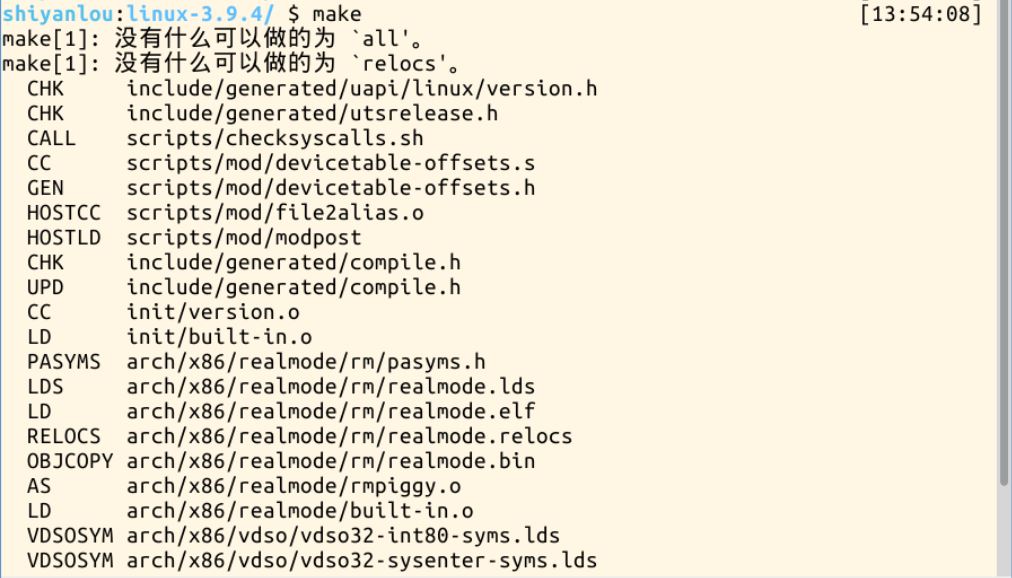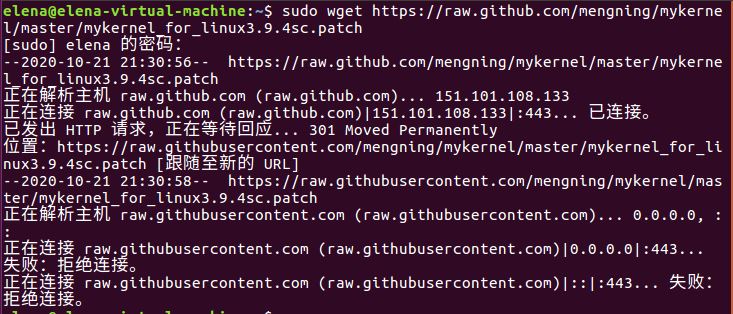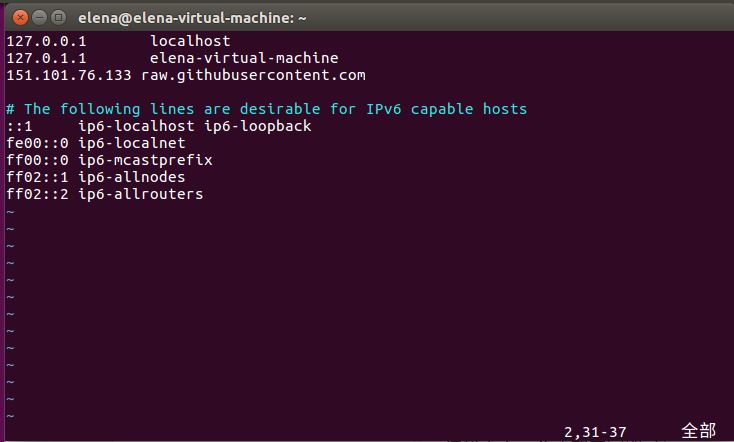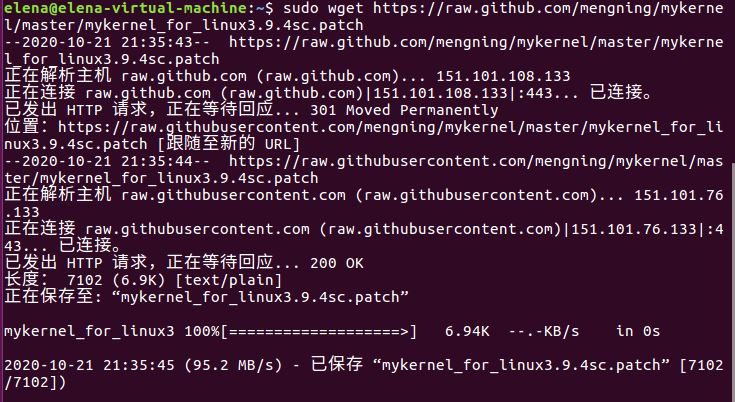时间片轮转多道程序内核代码分析
代码实现
使用实验楼的环境进行实验,结果如图:


在LinuxKernel/linux-3.9.4/mykernel目录下修改源代码:
在mypcb.h中定义PCB:
#define MAX_TASK_NUM 4
#define KERNEL_STACK_SIZE 1024*2
/* CPU-specific state of this task */
struct Thread {
unsigned long ip;
unsigned long sp;
};
typedef struct PCB{
int pid;
volatile long state; /* -1 unrunnable, 0 runnable, >0 stopped */
unsigned long stack[KERNEL_STACK_SIZE];
/* CPU-specific state of this task */
struct Thread thread;
unsigned long task_entry;
struct PCB *next;
}tPCB;
void my_schedule(void);
在mymain.c中实现内核代码的入口,负责初始化内核的各个组成部分:
#include <linux/types.h>
#include <linux/string.h>
#include <linux/ctype.h>
#include <linux/tty.h>
#include <linux/vmalloc.h>
#include "mypcb.h"
tPCB task[MAX_TASK_NUM];
tPCB * my_current_task = NULL;
volatile int my_need_sched = 0;
void my_process(void);
void __init my_start_kernel(void)
{
int pid = 0;
int i;
/* Initialize process 0*/
task[pid].pid = pid;
task[pid].state = 0;/* -1 unrunnable, 0 runnable, >0 stopped */
task[pid].task_entry = task[pid].thread.ip = (unsigned long)my_process;
task[pid].thread.sp = (unsigned long)&task[pid].stack[KERNEL_STACK_SIZE-1];
task[pid].next = &task[pid];
/*fork more process */
for(i=1;i<MAX_TASK_NUM;i++)
{
memcpy(&task[i],&task[0],sizeof(tPCB));
task[i].pid = i;
task[i].thread.sp = (unsigned long)(&task[i].stack[KERNEL_STACK_SIZE-1]);
task[i].next = task[i-1].next;
task[i-1].next = &task[i];
}
/* start process 0 by task[0] */
pid = 0;
my_current_task = &task[pid];
asm volatile(
"movl %1,%%esp
" /* set task[pid].thread.sp to esp */
"pushl %1
" /* push rbp */
"pushl %0
" /* push task[pid].thread.ip */
"ret
" /* pop task[pid].thread.ip to rip */
:
: "c" (task[pid].thread.ip),"d" (task[pid].thread.sp) /* input c or d mean %ecx/%edx*/
);
}
int i = 0;
void my_process(void)
{
while(1)
{
i++;
if(i%10000000 == 0)
{
printk(KERN_NOTICE "this is process %d -
",my_current_task->pid);
if(my_need_sched == 1)
{
my_need_sched = 0;
my_schedule();
}
printk(KERN_NOTICE "this is process %d +
",my_current_task->pid);
}
}
}
在myinterrupt.c中实现进程切换:
#include <linux/types.h>
#include <linux/string.h>
#include <linux/ctype.h>
#include <linux/tty.h>
#include <linux/vmalloc.h>
#include "mypcb.h"
extern tPCB task[MAX_TASK_NUM];
extern tPCB * my_current_task;
extern volatile int my_need_sched;
volatile int time_count = 0;
/*
* Called by timer interrupt.
* it runs in the name of current running process,
* so it use kernel stack of current running process
*/
void my_timer_handler(void)
{
if(time_count%1000 == 0 && my_need_sched != 1)
{
printk(KERN_NOTICE ">>>my_timer_handler here<<<
");
my_need_sched = 1;
}
time_count ++ ;
return;
}
void my_schedule(void)
{
tPCB * next;
tPCB * prev;
if(my_current_task == NULL
|| my_current_task->next == NULL)
{
return;
}
printk(KERN_NOTICE ">>>my_schedule<<<
");
/* schedule */
next = my_current_task->next;
prev = my_current_task;
if(next->state == 0)/* -1 unrunnable, 0 runnable, >0 stopped */
{
my_current_task = next;
printk(KERN_NOTICE ">>>switch %d to %d<<<
",prev->pid,next->pid);
/* switch to next process */
asm volatile(
"pushl %%ebp
" /* save ebp of prev */
"movl %%esp,%0
" /* save esp of prev */
"movl %2,%%esp
" /* restore esp of next */
"movl $1f,%1
" /* save rip of prev */
"pushl %3
"
"ret
" /* restore rip of next */
"1: " /* next process start here */
"popl %%ebp
"
: "=m" (prev->thread.sp),"=m" (prev->thread.ip)
: "m" (next->thread.sp),"m" (next->thread.ip)
);
}
return;
}
执行结果如图:

代码分析
进程初始化
初始化一个进程的内嵌汇编代码如下:
asm volatile(
"movl %1,%%esp
"
"pushl %1
"
"pushl %0
"
"ret
"
"popl %%ebp
"
:
: "c" (task[pid].thread.ip),"d" (task[pid].thread.sp)
);
movl %1,%%esp:将esp指向task[0].thread.sp,此时esp和ebp都指向进程0的堆栈栈底pushl %1:将ebp的值入栈,即esp移动一个存储单元,将task[0].thread.sp压入栈中pushl %0:将0号进程的入口task[0].thread.ip压入栈中ret:将当前栈顶的值弹出至eip中,即将task[0].thread.ip存入eip,表示接下来即将启动0进程popl %%ebp:作为编码习惯出现,不会被执行
进程切换
假设系统有进程0和进程1,若由当前的进程0切换至进程1,则进行如下操作:
asm volatile(
"pushl %%ebp
"
"movl %%esp,%0
"
"movl %2,%%esp
"
"movl %2,%%ebp
"
"movl $1f,%1
"
"pushl %3
"
"ret
"
"1: "
"popl %%ebp
"
: "=m" (prev->thread.sp),"=m" (prev->thread.ip)
: "m" (next->thread.sp),"m" (next->thread.ip)
);
pushl %%ebp:在栈中保存进程0的ebpmovl %%esp,%0:在prev->thread.sp中保存进程0的espmovl %2,%%esp:将esp指向next->thread.sp,将工作堆栈切换到进程1的堆栈空间movl %2,%%ebp:将ebp指向进程1的栈底movl $1f,%1:将$1f保存至进程0的thread.ippushl %3:在进程1的堆栈空间中,将task[1].thread.ip压入栈中ret:将栈顶的task[1].thread.ip弹出至eip中,即将执行进程11::与$1f配合使用,表示再次切换进程0时从标号1处开始执行popl %%ebp:作为编码习惯出现,不会被执行
问题与总结
问题1:最初的想法是在自己的Ubuntu16.04虚拟机中进行实验,在按照教材执行wget https://raw.github.com/mengning/mykernel/master/mykernel_for_linux3.9.4sc.patch时,出现如下错误:

解决方法如下:
首先查询raw.githubusercontent.com的IP:

然后将151.101.76.133 raw.githubusercontent.com添加到/etc/hosts文件中:


再次执行命令,发现问题已解决:

问题2:在自己的虚拟机进行make时,出现如下错误:

于是我根据网络上的教程不小心将gcc相关配置文件删除了,最终也没能解决,于是决定还原虚拟机备份并在实验楼做实验。
最后,总结一下操作系统是如何工作的:
Linux操作系统由内核来实现具体工作。创建或切换一个进程时,首先将原本正在运行的进程的上下文保存在堆栈中,然后将新进程的上下文信息加载到相应的寄存器中,并运行当前新进程;运行完毕后根据系统的调度继续执行相应的操作。